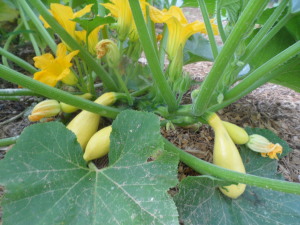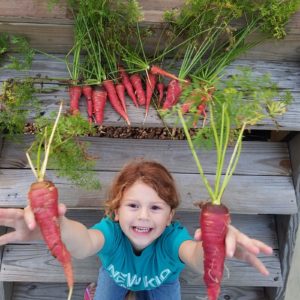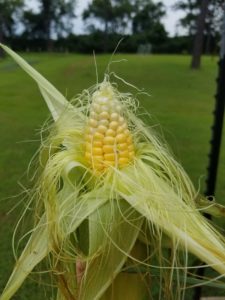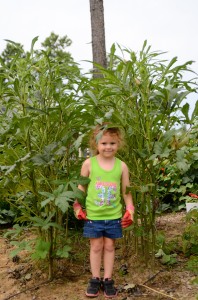9 Vegetables You Should ONLY Plant from Seed
I love walking into garden centers and local nurseries in the spring. Aisles of beautiful plants beg to chosen, like cute little puppies at the animal shelter. The endless selection prompts our minds to start dreaming of the garden we could have this year.
It is fun to plant baby plants (or transplants). We can see them right away and we don’t have to wait on a seed to germinate or worry that it won’t.
But not all plants thrive when moved into the garden. Some of them have a hard time adjusting to the change in environment. Some produce deep roots that a transplant pot can’t contain. Others don’t acclimate well if they’ve spent more time in a greenhouse than in the sun.
Plus, have you checked the price of transplants lately? Depending on the plant, you could be shelling out $4 per plant or more. Even with a small raised bed with a few plants, your garden can get expensive in a hurry.
So, which vegetables should you plant ONLY from seed?

Beans and Peas
Beans and peas (both green peas and black-eyed peas) thrive when planted by seed in their native soil. Their roots spread horizontally, commanding more lateral space than other plants.
They also germinate well. Peas, because they are planted in the early spring — when the weather and soil temperature are cooler — can take up to 2 weeks to germinate, but when they do, they’re all in.
Beans germinate quickly in warm soil and can take a bit longer the earlier you plant them.
Don’t forget the cost factor here. If you want to grow enough beans to last you all season (like I do), you’ll need to plant 100-200 seeds. Purchasing those seeds will only cost you a couple of bucks, but buying transplants can set you back — and that’s assuming they all survive the transplant.
When to plant beans and peas? Plant green peas (snow, snap, shelling) one month before your average last frost date. Plant beans and black-eyed peas after the danger of frost has passed and the soil has warmed to at least 70 degrees.

Squash, Zucchini, Cucumbers, and Melons
The Cucurbita family (squash, zucchini, cucumbers and melons) are some of the most popular plants to buy at the garden center. Don’t give into the temptation! While I have had these transplants do well, they, like beans and peas, have a hard time acclimating to transplanting. This is especially true the earlier in the season you plant them.
When you plant these crops directly from seed, they will grow and thrive and in many cases catch up to the ones you planted as transplants at the same time. Because they don’t have to adjust to a new environment, you’re setting yourself up for a healthier plant and a greater harvest by planting from seed.
When to plant? Plant them after the danger of frost has passed and soil has warmed to 70 to 75 degrees.

Carrots
Carrots develop their fruit in their root, and that root doesn’t like to be disturbed. If you ever pick a young carrot, you can see even the tiniest root hairs protruding from the carrot root. Those root hairs don’t do well when disturbed. Although carrot seeds take some time to germinate (a couple of weeks), be patient and keep them well-watered while you’re waiting for those little v-shaped seedlings to emerge.
When to plant carrots? Plant them in the earlier spring for a summer harvest, or even better, in the late summer for a fall harvest.

Corn
Corn is another crop that doesn’t like a change in its environment. And like the others, it’s easy to plant from seed as long as the soil has warmed. They germinate in a week or so.
And again, with corn, it’s a cost issue. For proper pollination, you need at least 4 rows of 4 plants of corn (at minimum) — which is 16 plants. If you do the math, you can tell that can get expensive if you buy transplants.

Okra
The main reason to plant okra from seed is because it’s too easy. As long as you wait until the soil has warmed, those seeds sprout quickly. And because okra develops a deep tap root, planting them in their permanent location gives them a start to the harvest.
I’ve planted okra transplants before and they’ve done just fine. And if your growing season is short, this may be your best option since they only thrive in hot weather. Still, if you live in the South, where your growing season is long, growing okra from seed is the cheapest and most convenient option.
Want more information on which plants are best planted by seed and which are best planted as transplants? Click below to listen to one of the most listened-to podcast episodes of the Beginner’s Garden Podcast: Seeds or Transplants? How to Know What to Plant
Do you get overwhelmed with garden planning?
Subscribe here for my best tips to plan your garden in just 7 days -- all for FREE.
Plus, I'll send you my "In the Garden E-mail" on Fridays, periodic updates on garden resources relevant to you, and you'll receive access to my entire bank of free garden downloads!
You are also agreeing to our privacy policy.


I never got success with okra. Will try this winter again.